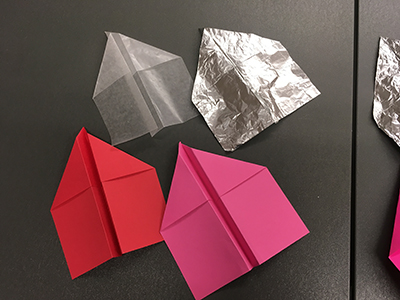What type of paper makes the best paper airplane?
Explore with youth the engineering and science behind making paper airplanes by asking questions and discovering answers.

The Michigan State University Extension science team’s goal is to increase science literacy across Michigan. One way we support an increased interest in science is to provide information and ideas for engaging youth in exploring their world. Adults can help youth increase their science literacy by encouraging them to ask questions and discover answers. Exploring paper airplanes is just one way to engage youth in STEM (Science, Technology, Engineering and Mathematics).
Help youth explore engineering by starting with the question, “What type of paper do you think will make the best paper airplane?” Record types of paper on a list as they discuss the kinds of paper that could be used to make a paper airplane.
Before beginning to make the paper airplanes, help youth understand what the “best” airplane is. It could mean many things; youth should take some time to clarify what makes one airplane better than another. Is it an airplane that flies the farthest, lands with the least amount of damage, flies in loops or maybe one that carries something? Why do you think it’s important to know what the plane needs to do before making them? Is this something airplane designers would need to know before they begin to design an airplane? Why would this be important to know?
Write the purpose of the airplane in a question form for everyone to refer to while folding their airplanes. For example, you might write, “What type of paper makes a paper airplane that can carry the most weight more than 10 feet?” For this question, you would need some uniform weights like small metal washers.
Encourage youth to work in pairs and pose these two additional questions for discussion:
- Will it influence my experimental results if each type of paper I use is a different size?
- Will it influence my experimental results if I fold a different style of airplane out of each type of paper?

While youth are designing, cutting and folding their airplanes, you should set up a testing area along one side of the room or in a hallway away from where youth are building. Blue painters tape is an easy way to mark an area including the starting point. Consider marking the distances with tape as well.
Increasing science literacy, asking questions and discovering answers, engages learners of all ages in the experiential inquiry-based learning process that helps them develop valuable problem-solving, critical-thinking and decision-making skills. This results in youth that are better equipped with life skills necessary for future success.
For more ways to share science with youth in your life, please explore the MSU Extension Science and Technology website. For more information about 4-H learning opportunities and other 4-H programs, contact your local MSU Extension office. To learn more about 4-H and Extension opportunities in Alcona County, stop by our Harrisville office at 320 S. US-23 or visit our Alcona County MSU Extension Facebook page.
MSU Extension and the Michigan 4-H Youth Development program help to create a community excited about STEM (Science, Technology, Engineering, and Mathematics). 4-H STEM programming seeks to increase science literacy, introducing youth to the experiential learning process that helps them to build problem-solving, critical-thinking and decision-making skills. Youth who participate in 4-H STEM are better equipped with critical life skills necessary for future success. To learn more about the positive impact of Michigan 4-H youth in STEM literacy programs, read our 2015 Impact Report: “Building Science Literacy and Future STEM Professionals.”



 Print
Print Email
Email




